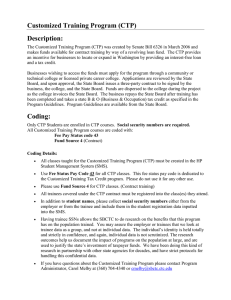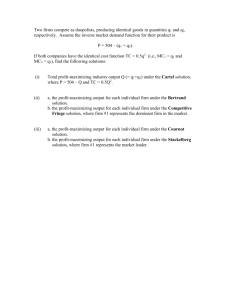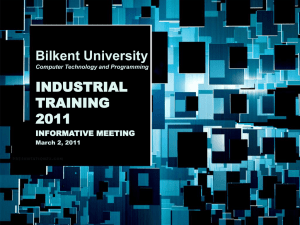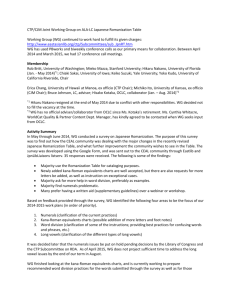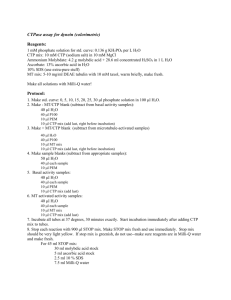Intra-Car Multi-hop Wireless Sensor Networking: A Case Study Morteza Hashemi , Wei Si
advertisement
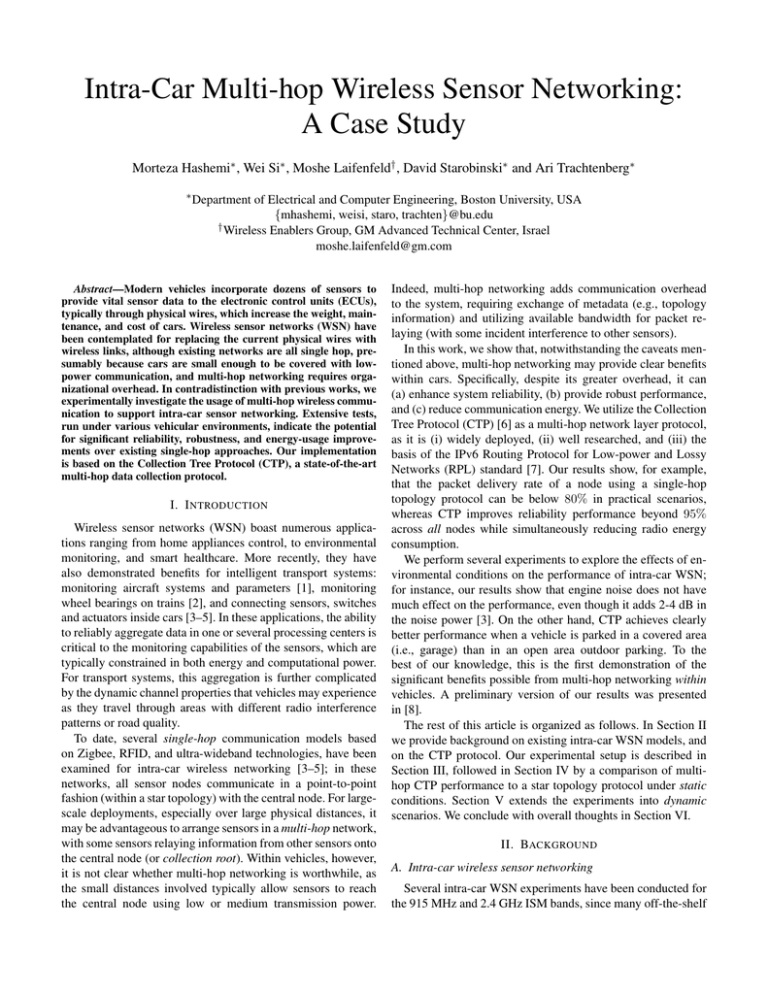
Intra-Car Multi-hop Wireless Sensor Networking:
A Case Study
Morteza Hashemi∗ , Wei Si∗ , Moshe Laifenfeld† , David Starobinski∗ and Ari Trachtenberg∗
∗ Department
of Electrical and Computer Engineering, Boston University, USA
{mhashemi, weisi, staro, trachten}@bu.edu
† Wireless Enablers Group, GM Advanced Technical Center, Israel
moshe.laifenfeld@gm.com
Abstract—Modern vehicles incorporate dozens of sensors to
provide vital sensor data to the electronic control units (ECUs),
typically through physical wires, which increase the weight, maintenance, and cost of cars. Wireless sensor networks (WSN) have
been contemplated for replacing the current physical wires with
wireless links, although existing networks are all single hop, presumably because cars are small enough to be covered with lowpower communication, and multi-hop networking requires organizational overhead. In contradistinction with previous works, we
experimentally investigate the usage of multi-hop wireless communication to support intra-car sensor networking. Extensive tests,
run under various vehicular environments, indicate the potential
for significant reliability, robustness, and energy-usage improvements over existing single-hop approaches. Our implementation
is based on the Collection Tree Protocol (CTP), a state-of-the-art
multi-hop data collection protocol.
I. I NTRODUCTION
Wireless sensor networks (WSN) boast numerous applications ranging from home appliances control, to environmental
monitoring, and smart healthcare. More recently, they have
also demonstrated benefits for intelligent transport systems:
monitoring aircraft systems and parameters [1], monitoring
wheel bearings on trains [2], and connecting sensors, switches
and actuators inside cars [3–5]. In these applications, the ability
to reliably aggregate data in one or several processing centers is
critical to the monitoring capabilities of the sensors, which are
typically constrained in both energy and computational power.
For transport systems, this aggregation is further complicated
by the dynamic channel properties that vehicles may experience
as they travel through areas with different radio interference
patterns or road quality.
To date, several single-hop communication models based
on Zigbee, RFID, and ultra-wideband technologies, have been
examined for intra-car wireless networking [3–5]; in these
networks, all sensor nodes communicate in a point-to-point
fashion (within a star topology) with the central node. For largescale deployments, especially over large physical distances, it
may be advantageous to arrange sensors in a multi-hop network,
with some sensors relaying information from other sensors onto
the central node (or collection root). Within vehicles, however,
it is not clear whether multi-hop networking is worthwhile, as
the small distances involved typically allow sensors to reach
the central node using low or medium transmission power.
Indeed, multi-hop networking adds communication overhead
to the system, requiring exchange of metadata (e.g., topology
information) and utilizing available bandwidth for packet relaying (with some incident interference to other sensors).
In this work, we show that, notwithstanding the caveats mentioned above, multi-hop networking may provide clear benefits
within cars. Specifically, despite its greater overhead, it can
(a) enhance system reliability, (b) provide robust performance,
and (c) reduce communication energy. We utilize the Collection
Tree Protocol (CTP) [6] as a multi-hop network layer protocol,
as it is (i) widely deployed, (ii) well researched, and (iii) the
basis of the IPv6 Routing Protocol for Low-power and Lossy
Networks (RPL) standard [7]. Our results show, for example,
that the packet delivery rate of a node using a single-hop
topology protocol can be below 80% in practical scenarios,
whereas CTP improves reliability performance beyond 95%
across all nodes while simultaneously reducing radio energy
consumption.
We perform several experiments to explore the effects of environmental conditions on the performance of intra-car WSN;
for instance, our results show that engine noise does not have
much effect on the performance, even though it adds 2-4 dB in
the noise power [3]. On the other hand, CTP achieves clearly
better performance when a vehicle is parked in a covered area
(i.e., garage) than in an open area outdoor parking. To the
best of our knowledge, this is the first demonstration of the
significant benefits possible from multi-hop networking within
vehicles. A preliminary version of our results was presented
in [8].
The rest of this article is organized as follows. In Section II
we provide background on existing intra-car WSN models, and
on the CTP protocol. Our experimental setup is described in
Section III, followed in Section IV by a comparison of multihop CTP performance to a star topology protocol under static
conditions. Section V extends the experiments into dynamic
scenarios. We conclude with overall thoughts in Section VI.
II. BACKGROUND
A. Intra-car wireless sensor networking
Several intra-car WSN experiments have been conducted for
the 915 MHz and 2.4 GHz ISM bands, since many off-the-shelf
Fig. 1. Placement of nodes inside the car for the suspension network and the engine network.
products (ZigBee, Bluetooth, RFID) operate at these frequencies. The authors in [3] characterize the physical layer of a
Zigbee-based sensor network inside a car; in particular, they
measure the Received Signal Strength Indicator (RSSI) and
Link Quality Indicator (LQI). The results in [4, 9, 10] provide
comprehensive statistics for the intra-car channel, including its
power delay profile (PDP), coherence bandwidth and coherence
time. Other fading statistics, such as level-crossing rate (LCR)
and average fading duration (AFD), have also been measured
in these works. In [5], ultra-wideband (UWB) technology is
considered for short range communication within a car due to
its low power requirements and high data rate.
In contrast to the previous works, we investigate the performance of an intra-car multi-hop WSN on a commercial TelosB
platform. Multi-hop data collection can potentially compensate
for large channel losses. For example, the results in [10] show
that the average channel loss of a link between a transmitter
(located in the engine compartment) and a receiver (placed
inside the trunk) is about 85 dB. Considering the receiver
sensitivity of the sensor’s radio chip (e.g., the CC2420 has
a sensitivity of -94 dBm (typ) and -90 dBm (min)), one can
conclude that sensor nodes should always transmit at high
power to overcome such channel loss. On the other hand, the
situation is different for a multi-hop network, wherein sensor
nodes can opportunistically choose the next hop according
to on-going channel conditions and decrease the transmission
power while communicating reliably, possibly at the expense
of increased latency and decreased network throughput. Our
work thus aims to concretely evaluate the cost-benefit regions
of multi-hop WSN inside cars.
B. Collection Tree Protocol
The Collection Tree Protocol (CTP) is a variant of a distancevector routing protocol that includes optimization tailored for
wireless sensor networks. CTP is designed to route data from
every node on a network to one or more self-declared root
nodes, based on minimum cost trees. In [6] a variant of CTP
is introduced, in which the expected number of transmissions,
denoted by ETX, is used as the cost metric. In this approach,
each node that has a message to transmit attempts to build a
shortest-path tree with a minimum number of transmissions
toward the root. The calculation of ETX for each node is done
as follows: consider two nodes A and B such that node A is the
parent of node B, then we have:
ETXB = ETXA + ETX of link B → A;
ETXRoot = 0,
where the ETX of a link is estimated by a link estimator in
a distributed fashion [6]. Given a choice of valid routes, CTP
simply chooses the one with the lowest ETX toward the root.
III. E XPERIMENTAL S ETUP
A. Experimental methodology
In the experiments, we evaluate two distinct networks operating on different frequencies inside a car: a suspension network
and an engine network. Each network consists of four sensor
nodes periodically sending data to the collection root, which
itself is connected to a laptop through a USB port for the
purposes of logging messages and statistics for post-experiment
analyses. Fig. 1 graphically illustrates the placement of nodes
in the car. Note that previous studies (see, for example, [10])
show that wireless channels to other locations in the vehicle
show more-or-less similar characteristics, i.e., slow fading with
coherence time of several seconds.
In addition to the sensor nodes and the collection root, we
utilize an activator node (not shown in Fig. 1) to send an initial
broadcast signal that activates each sensor node and establishes
basic time synchronization. The use of an activation broadcast
enables us to dictate the packet generation rate, transmission
power, and radio channel for the nodes. The activator node is
chosen to be different from the root node because all nodes
should receive the activation signal, while the signal of the root
may not be received by all nodes under low-power transmission.
Therefore, we use the activator node to send a high-power
broadcast signal received by all sensors.
Our sensor nodes are TelosB (TPR2420CA) [11] with a
data rate of 250 kbps, RF power -24 dBm to 0 dBm, and
TABLE I
E XPERIMENTAL SCENARIOS
Location
Scenario
Dynamic conditions
Engine
Passengers
WiFi
Static
Engine-on
Passengers
WiFi interference
Static
Off
On
Off
Off
Off
No
No
Yes
No
No
Weak1
Weak
Weak
Strong2
Weak
Bumpy road
Highway
Urban area
On
On
On
Yes
Yes
Yes
Weak
Weak
Strong3
Parking
Covered area
Open area
Driving
On the road
1
2
3
In-band WiFi interference is negligible.
Controlled WiFi interference is exerted to the experiment setup.
There exist considerable urban wireless interferences.
receiver sensitivity of -94 dBm (typ) through -90 dBm (min).
The sensor nodes’ firmware is based on TinyOS 2.x, which is
an open source operating system designed for sensor networks.
The radio chip of sensor nodes (CC2420) is configured to use
a Carrier Sense Multiple Access (CSMA) MAC protocol for
transmission through the shared wireless medium.
We investigate CTP performance under several conditions,
summarized in Table I. The experiments are performed in (i)
a covered area parking with little foot traffic and several cars
parked nearby, (ii) an open area parking, and (iii) a local road,
highway, or an urban area. The condition of an experiment can
be either static or dynamic, with the latter referring to cases
when the engine is on, or passengers move in and out of the
vehicle, or WiFi interferences are present.
B. Sensors data collection
In real deployment of intra-car WSNs, data packets contain
physical measurements of sensors such as tire pressure in a
Tire Pressure Monitoring System (TPMS), engine torque, or
transmission pressure. For instance, a Transmission Control
Module (TCM) controls automatic transmissions in modern
vehicles. TCM uses readings from transmission sensors as well
as data provided by the ECUs to change gears for optimum
performance in terms of fuel efficiency and shift quality [12].
In the experiments, however, we have abstracted the payload
of packets (shown in Fig. 2) into information that is needed
to calculate performance metrics of the network. For instance,
when a sensor node receives a packet, it updates payload of
the packet with some metadata (e.g., hop ID and RSSI information) and forwards it to the next hop. Payload fields are then
processed in a post-experiment step using our developed toolkit
in [13] to calculate the performance metrics and display the
evolution of the network topology. In the experiments, sensor
nodes generate packets with a size of 32 bytes including 8 bytes
of CTP data packet header, 12 bytes of payload, and 12 bytes
of CC2420 header.
Fig. 2. Payload fields of a packet
Throughout the experiments, we measure the average delivery rate, delay, and number of transmissions per packet,
denoted by Tx count. Assuming that in an experiment lasting
T seconds, sensors generate M packets in total from which N
packets are successfully received by the root. Among the total
N received packets, Nu packets are unique (i.e., all duplicates
are removed from the count). The delivery rate is then defined
as the ratio of uniquely received packets to the total number
of generated packets ( NMu × 100%). The delay of a delivered
packet is the time elapsing from its generation at the source
node till its reception at the root. Tx count is the number of total
transmissions (including at relay nodes) per received packet at
the root.
IV. E XPERIMENTAL R ESULTS : S TATIC C ONDITIONS
In this section, we compare the performance of CTP with a
single-hop star protocol under static conditions.
A. Reliability
In a star protocol all nodes communicate directly with the
root, and thus, if some node-to-root links experience deep channel fading then the quality of service for that node degrades,
while an intra-car WSN should guarantee high reliability across
all nodes. For instance, in a TPMS network, each sensor node
attached to a tire should be able to successfully deliver measured parameters to the central processors. Within this context,
we examine the delivery rate of individual nodes using CTP and
the star protocol. As the results in Fig. 3 show, CTP provides
high delivery rate across all nodes, whereas the performance of
the star protocol varies significantly. For example, node 4 has
a delivery rate of 78% with high variance showing that nodes
can have varying performance over time depending on the link
conditions. From the network topology shown in Fig. 4, we
observe that the topology induced by CTP is indeed multi-hop,
in counterpoint to the single-hop topology of the star protocol.
B. Communication and latency trade-offs
In wireless sensor networks power consumption and delay
have significance for battery-powered and delay-limited applications. While comparing multi-hop with single-hop, some
trade-offs emerge: a multi-hop topology may require more
transmissions per packet due to relay nodes, but nodes can
transmit with lower power to achieve the same delivery rate
as a single-hop protocol. For instance, our experimental results
show that CTP with a transmit power of −10 dBm can provide
CTP
Star
Condition
Tx power
Protocol
Tx count
Delay
Delivery
Static
-20 dBm
Star
CTP
1.14
1.72
14.36
37.35
92.69%
96.43%
Passengers
-10 dBm
Star
CTP
1.22
2.54
16.72
82.92
92.59%
98.41%
Delivery rate(%)
100
90
TABLE II
CTP AND THE STAR PROTOCOL PERFORMANCE . T X COUNT AND DELAY
ARE CALCULATED BASED ON THE DELIVERED PACKETS .
80
70
60
1
2
3
CTP
Star
4
100
Fig. 3. Delivery rate of CTP vs. the star protocol under static conditions, Tx
power −20 dBm and generation rate 15 pkts/sec per node. The error bars show
one standard deviation from the mean over 5 six-minutes experiments.
2
3
1
2
80
70
1
(a) CTP topology
90
0
0
4
4
Delivery rate(%)
Node ID
3
(b) Star topology
60
Fig. 4. CTP multi-hop topology vs. the single-hop topology of the star protocol
the same reliability as the star protocol with a transmit power
of 0 dBm, at the cost of only up to 69% higher Tx count per
packet. Specifically, the radio of TelosB motes (CC2420) draws
11 mA current to transmit at a power of −10 dBm and 17.4
mA to transmit at a power of 0 dBm [14]. On the other hand,
the receive mode requires a current of 18.8 mA, noting that in
our application, the radio is almost always listening for incoming messages, which implies that the radio consumes roughly
the same amount of receive power regardless of transmission
activity. Based on the number of transmissions and transmit
power, we conclude that CTP provides energy savings for the
radio component. Previous experiments and simulations in [15]
show that energy consumption by the radio is dominant in
wireless sensor motes. However, it should be noted that other
components, such as the processor, consume energy, and that
their energy consumption depends on the instructions run by
the mote.
Single-hop delay is also expected to be smaller than multihop delay, but a single-hop protocol is not always reliable and
retransmissions are required. Table II compares the average Tx
count and delay performance of CTP and the star protocol. The
results confirm that a star protocol requires fewer transmissions
and incurs lower delay, but CTP provides a higher delivery rate.
While the average delivery rate of the star protocol may not be
significantly worse than CTP, individual nodes can experience a
low delivery rate within the star protocol (e.g., node 4 in Fig. 3).
1
2
3
4
5
6
8
9
Node ID
Fig. 5. Delivery rate of CTP vs. the star protocol under static conditions for
the 8-nodes network. The packet generation rate is 5 pkts/sec per node and the
transmission power is set to −10 dBm.
C. Reliability in larger network
To generalize the previous reliability results, we merge the
suspension network and the engine network into one network
with eight sensors and one collection root (see Fig. 1). From
the delivery rate results shown in Fig. 5, one can notice that the
performance of CTP is more reliable and stable across all nodes.
In fact, different nodes in the star protocol achieve varying
levels of reliability, but CTP reduces variance in performance
among the different nodes and all of them achieve a delivery
rate higher than 98%.
V. E XPERIMENTAL R ESULTS : DYNAMIC C ONDITIONS
We next investigate the performance of CTP and the star
protocol under dynamic in-vehicle conditions.
A. CTP vs. Star protocol under dynamic conditions
An intra-car wireless sensor network can experience various
environmental conditions, such as when the car travels through
areas with intense wireless interference, or when passengers
are sitting inside the vehicle, which can cause link fluctuations.
However, an intra-car WSN should provide robust performance
regardless of environmental conditions. Within this context,
we compare the performance of CTP and the star protocol
CTP
Star
100
90
90
Delivery rate (%)
Delivery rate(%)
CTP
Star
100
80
70
80
70
60
1
2
3
60
4
Node ID
1
2
3
4
Node ID
(a) Passengers-move-in-and-out scenario
(b) WiFi interference
Fig. 6. Delivery rate of CTP vs. the star protocol (a) under Passengers-move-in-and-out scenario (b) with WiFi interferences, Tx power −10 dBm and generation
rate 10 pkts/sec per node. The error bars show one standard deviation from the mean over 5 six-minutes experiments.
1
3
2
120
3
100
2.5
80
2
Suspension
Engine
0
(b) WiFi interference
Fig. 7. Multi-hop CTP topology under (a) passengers-move-in-and-out scenario (b) with WiFi interference.
under two common dynamic scenarios: (i) when passengers
are sitting inside the vehicle, and (ii) in the presence of Wi-Fi
interferences. Fig. 17(a) shows the delivery rate of individual
nodes when two passengers move in and out of the vehicle. The
results indicate that CTP provides stable and reliable performance across all nodes, whereas the star protocol has worse
delivery rate. For instance, only 82% of the packets generated
at node 2 are successfully received by the root. Fig. 17(b)
compares the performance of CTP and the star protocol in the
presence of WiFi interferences. Likewise, we observe that there
are individual nodes within the star protocol that fail to achieve
high delivery rate. The network topology induced by CTP
under dynamic conditions is shown in Fig. 7, which confirms
that multi-hop topology can provide robust performance under
dynamic conditions.
B. CTP supplementary experiments
In this part, we extend the experiments of CTP to investigate
its performance sensitivity to various environmental conditions.
Open area vs. covered area: Due to the broadcast nature of
wireless signals, the presence of surrounding objects, like walls
and ceilings, affects wireless network performance. Within this
90
Delay (ms)
(a) Passengers-move-in-and-out scenario
Delivery rate (%)
100
80
70
Tx count
4
60
1.5
40
1
20
0.5
60
50
40
Covered Open
0
Covered Open
0
Covered Open
Fig. 8. CTP performance of the suspension network and the engine network
in a covered and an open area parking with Tx power −10 dBm and the packet
generation rate 10 pkts/sec per node.
context, CTP performance is examined in both covered and
open area parking. Results shown in Fig. 8 indicate that CTP
achieves better performance in the covered area parking. We
speculate that this could be due to more multi-path signaling
in the covered area, which adds up to create a strong almostconstant signal at the receiver; an open area is potentially
a poor multi-path environment, which is consistent with the
experimental results in [10].
Engine-on, with Passengers: Physical channels inside a car
can be highly dynamic due to external disturbances such as
when the car engine is on, or when passengers move in and out
of the vehicle. Fig. 9 shows the performance of the suspension
network under such conditions. The results illustrate that CTP
achieves a delivery rate above 98%, and that engine noise does
not have considerable effect on overall system performance.
However, delay and Tx count performance degrade with passengers movements, indicating that human body can cause
channel fading that may be attributed to the large attenuation
of biological tissues in the 2.4 GHz range [16].
Driving experiments: Data collection from intra-car wire-
CTP performance of suspension network
Delay (ms)
Delivery rate (%)
90
80
120
3
100
2.5
80
2
Tx count
Static
Engine−on
Passengers 100
60
1.5
40
1
20
0.5
70
60
−10 dBm
0
0 dBm
Tx power
−10 dBm
0
0 dBm
Tx power
−10 dBm
0 dBm
Tx power
Fig. 9. CTP performance under engine-on and passengers-move-in-and-out conditions for the suspension network and the packet generation rate 10 pkts/sec per
node.
140
Suspension
Engine
100
3
120
2.5
100
2
80
80
Tx count
Delay (ms)
Delivery rate (%)
90
60
1.5
1
40
70
0.5
20
60
Bumpy Highway Urban
0
Bumpy Highway Urban
0
Bumpy Highway Urban
Fig. 10. CTP performance of the suspension network and the engine network within various driving conditions. Tx power is set to −10 dBm and the packet
generation rate is 10 pkts/sec per node.
less sensors is complicated by the variety of conditions a car
experiences. As such, driving experiments play a critical role
in performance assessment of an intra-car WSN. To fulfill
this evaluation goal, CTP experiments are performed within
three driving conditions: (i) bumpy road with poor road quality, (ii) highway with sparse and high speed vehicular traffic,
and (iii) urban area with dense vehicular traffic and wireless
interference (WiFi, Bluetooth, etc.). Driving results shown in
Fig. 10 illustrate that both networks have a delivery rate higher
than 90% under various driving conditions. The performance of
the suspension network, whose sensor nodes are attached to the
suspension system of wheels, is most affected when driving on
the bumpy road. High speed driving on a highway does not have
noticeable effect on both networks and driving in urban areas
does not have considerable effect on the suspension network
either, but the delivery rate of the engine network degrades in
urban areas, presumably due to wireless interferences.
WiFi interference: Sensor radios based on the IEEE
802.15.4 standard can highly suffer from external interferences,
as they use the same frequency band as the IEEE 802.11
standard. To investigate the performance of CTP under interferences, we run a series of controlled WiFi experiments,
wherein sensor nodes are configured to operate on the same
frequency as a local WiFi network (channel 22 under 802.15.4
standard and channel 11 of 802.11 standard). External interferences are applied within two intensity levels: (i) light WiFi
that reflects a “normal” WiFi usage by local users, and (ii)
heavy WiFi that is exerted by streaming a video on a close
CTP performance of suspension network
250
Static
Light WiFi
Heavy WiFi 100
3.5
3
200
2.5
80
150
Tx count
Delay (ms)
Delivery rate (%)
90
100
2
1.5
70
1
50
60
0.5
50
−10 dBm
0
0 dBm
−10 dBm
Tx power
0
0 dBm
−10 dBm
Tx power
0 dBm
Tx power
(a) Performance of the suspension network under WiFi interference
CTP performance of engine network
3.5
Static
Light WiFi
Heavy WiFi 100
400
3
90
2.5
80
Tx count
Delay (ms)
Delivery rate (%)
300
200
2
1.5
70
1
100
60
0.5
50
−10 dBm
0 dBm
0
−10 dBm
Tx power
0 dBm
0
−10 dBm
Tx power
0 dBm
Tx power
(b) Performance of the engine network under WiFi interference
Fig. 11. CTP performance under external WiFi interference for (a) the suspension network and (b) the engine network with the packet generation rate 10 pkts/sec
per node.
proximity computer located on the passenger’s seat. From the
results shown in Fig. 18(b), we observe that the engine network
is more vulnerable to WiFi interference, especially with low
transmission power. This observation is consistent with driving
experiment results in the urban area with wireless interferences.
It is also evident that intense WiFi interference deteriorates both
networks’ performance due to low SNR at the nodes’ receivers.
VI. C ONCLUSION
In this article we have investigated the performance of CTP
as a multi-hop data collection approach, as a counterpoint
to the star protocol that dominates the existing literature for
intra-car wireless sensor networks. Through experiments, we
demonstrate that the delivery rate of the star protocol can be
low in practical scenarios, while CTP achieves a reliability
of more than 90% across all nodes. Whereas a star protocol
requires fewer transmissions and incurs lower average delay
than CTP, the radio energy consumption of CTP is smaller.
Our experimental results indicate that environmental conditions
have widely differing effects on network performance. For
instance, passengers cause channel fading and degrade overall
system performance, while engine noise on the order of 24 dB does not have noticeable effect on performance. External
intense interferences (WiFi, Bluetooth, etc.) potentially deteriorate network performance, but CTP sustains its high delivery
rate (higher than 90%) in various driving conditions. These
results serve as an illustration of the cost-benefit regions of
multi-hop WSN inside cars.
Overall, our experimental results show that multi-hop networking enhances many aspects of network performance, and
may be suitable for intra-car networks due to their need for
robust operation in harsh environments. In future works, we
plan to explore hybridized collection protocols that blend reliability with other desired performance metrics, like throughput
optimality.
ACKNOWLEDGEMENT
The work presented here was supported by General Motors,
Advanced Technical Center, Israel.
B IOGRAPHIES
Morteza Hashemi (mhashemi@bu.edu) received his B.Sc.
(2011) in Electrical Engineering from Sharif University of
Technology, Tehran, Iran. He is currently a PhD student in
Electrical and Computer Engineering at Boston University.
His research interests include error correcting code, networks
performance evaluation, and wireless communications.
Wei Si (weisi@bu.edu) received B.S. degree from Shanghai
Jiao Tong University, Shanghai, China, in 2010. Currently, he
is working towards his Ph.D. degree in Systems Engineering
at Boston University. His research interests include routing
protocols for intra-car wireless sensor networks and disruption
tolerant networks, data synchronization algorithms and
queueing theory.
Moshe Laifenfeld (moshe.laifenfeld@gm.com) received
his BSc from the Technion in 1992, his MSc from Tel-Aviv
University in 1998, and his Ph.D. from Boston University
in 2008, all in electrical and computer engineering. Moshe
then took a joint post-doctoral position at MIT and Boston
University, where he focused on aspects of coding theory in
communication networks. Since then he is with General
Motors, focusing on R&D of novel hybrid in-vehicle
electrical architectures. In his past, Moshe led the algorithms
development of a 3rd generation UMTS transceiver, and held
several R&D positions in medical devices start-ups.
David Starobinski (staro@bu.edu) is a Professor of Electrical
and Computer Engineering at Boston University, with a joint
appointment in the Division of Systems Engineering. He
received his Ph.D. in Electrical Engineering from the Technion
- Israel Institute of Technology, in 1999. His research
interests are in wireless networking, network economics, and
cybersecurity.
Ari Trachtenberg (trachten@bu.edu) is a Professor of Electrical and Computer Engineering at Boston University. He
received his Ph.D. (2000) and M.S. (1996) in Computer Science
from the University of Illinois at Urbana/Champaign, and his
S.B. from MIT (1994) in math with CS. His research interests
include cybersecurity (smartphones, cryptography), networking
(security, sensors, localization), algorithms (data synchronization, file edits, file sharing), and error-correcting codes (rateless
coding, feedback).
R EFERENCES
[1] CHOSeN:
Cooperative
hybrid
objects
sensor
networks.
http://www.chosen.eu.
[2] Mathias Grudén, Alexander Westman, Janis Platbardis, P Hallbjorner, and
Anders Rydberg. Reliability experiments for wireless sensor networks in
train environment. In Wireless Technology Conference, EuWIT, pages 37–
40. IEEE, 2009.
[3] Hsin-Mu Tsai, Ozan K Tonguz, Cem Saraydar, Timothy Talty, Michael
Ames, and Andrew Macdonald. Zigbee-based intra-car wireless sensor
networks: a case study. Wireless Communications, IEEE, 14(6):67–77,
2007.
[4] Ozan K Tonguz, Hsin-Mu Tsai, Timothy Talty, Andrew Macdonald, and
Cem Saraydar. RFID technology for intra-car communications: a new
paradigm. In Vehicular Technology Conference, VTC Fall. IEEE 64th,
pages 1–6, 2006.
[5] W. Niu, J. Li, and T. Talty. Intra-vehicle uwb channels in moving
and staionary scenarios. In Military Communications Conference, 2009.
MILCOM 2009. IEEE, pages 1–6. IEEE, 2009.
[6] Omprakash Gnawali, Rodrigo Fonseca, Kyle Jamieson, Maria Kazandjieva, David Moss, and Philip Levis. CTP: An efficient, robust, and
reliable collection tree protocol for wireless sensor networks. ACM
Transactions on Sensor Networks (TOSN), 10(1):16, 2013.
[7] Tim Winter. RPL: IPv6 routing protocol for low-power and lossy
networks. 2012.
[8] Morteza Hashemi, Wei Si, Moshe Laifenfeld, David Starobinski, and Ari
Trachtenberg. Intra-car wireless sensors data collection: A multi-hop
approach. In Vehicular Technology Conference, VTC Spring. IEEE 77th,
pages 1–5, 2013.
[9] Hsin-Mu Tsai, Wantanee Viriyasitavat, Ozan K Tonguz, Cem Saraydar,
Timothy Talty, and Andrew Macdonald. Feasibility of in-car wireless
sensor networks: A statistical evaluation. In Sensor, Mesh and Ad Hoc
Communications and Networks. SECON’07. 4th Annual IEEE Communications Society Conference on, pages 101–111, 2007.
[10] Amir R Moghimi, Hsin-Mu Tsai, Cem U Saraydar, and Ozan K Tonguz.
Characterizing intra-car wireless channels. Vehicular Technology, IEEE
Transactions on, 58(9):5299–5305, 2009.
[11] MEMSIC. Telosb specification. http://www.memsic.com.
[12] Kobi Vaknin, Moshe Laifenfeld, Leor Hardy, and Aviv Goll. Experimenting with a wireless mesh network towards sensing inside a vehicle’s
transmission. In IEEE International Conference on Microwaves, Communications, Antennas and Electronics Systems (COMCAS), pages 1–5,
2013.
[13] Wei Si, Morteza Hashemi, Idan Warsawski, Moshe Laifenfeld, David
Starobinski, and Ari Trachtenberg. TeaCP: A toolkit for evaluation and
analysis of collection protocols in wireless sensor networks. In IEEE
International Conference on Microwaves, Communications, Antennas
and Electronics Systems (COMCAS), pages 1–5, 2013.
[14] CC2420 radio. http://www.ti.com.cn/cn/lit/ds/symlink/cc2420.pdf.
[15] Aggeliki S. Prayati, Christos Antonopoulos, Tsenka Stoyanova, Christos
Koulamas, and George D. Papadopoulos. A modeling approach on the
TelosB WSN platform power consumption. Journal of Systems and
Software, 83(8):1355–1363, 2010.
[16] Julien Ryckaert, Philippe De Doncker, René Meys, Arnaud de Le Hoye,
and Sophie Donnay. Channel model for wireless communication around
human body. Electronics letters, 40(9):543–544, 2004.
Fig. 12. Placement of nodes inside the car for the suspension network and the engine network.
TABLE III
E XPERIMENTAL SCENARIOS
Location
Scenario
Dynamic conditions
Engine
Passengers
WiFi
Static
Engine-on
Passengers
WiFi interference
Static
Off
On
Off
Off
Off
No
No
Yes
No
No
Weak1
Weak
Weak
Strong2
Weak
Bumpy road
Highway
Urban area
On
On
On
Yes
Yes
Yes
Weak
Weak
Strong3
Parking
Covered area
Open area
Driving
On the road
1
2
3
In-band WiFi interference is negligible.
Controlled WiFi interference is exerted to the experiment setup.
There exist considerable urban wireless interferences.
Fig. 13. Payload fields of a packet
CTP
Star
Delivery rate(%)
100
90
80
70
60
1
2
3
4
Node ID
Fig. 14. Delivery rate of CTP vs. the star protocol under static conditions, Tx power −20 dBm and generation rate 15 pkts/sec per node. The error bars show one
standard deviation from the mean over 5 six-minutes experiments.
2
3
1
0
0
4
4
2
1
(a) CTP topology
3
(b) Star topology
Fig. 15. CTP multi-hop topology vs. the single-hop topology of the star protocol
Condition
Tx power
Protocol
Tx count
Delay
Delivery
Static
-20 dBm
Star
CTP
1.14
1.72
14.36
37.35
92.69%
96.43%
Passengers
-10 dBm
Star
CTP
1.22
2.54
16.72
82.92
92.59%
98.41%
TABLE IV
CTP AND THE STAR PROTOCOL PERFORMANCE . T X COUNT AND DELAY ARE CALCULATED BASED ON THE DELIVERED PACKETS .
CTP
Star
Delivery rate(%)
100
90
80
70
60
1
2
3
4
5
6
8
9
Node ID
Fig. 16. Delivery rate of CTP vs. the star protocol under static conditions for the 8-nodes network. The packet generation rate is 5 pkts/sec per node and the
transmission power is set to −10 dBm.
CTP
Star
Delivery rate(%)
100
90
80
70
60
1
2
3
4
Node ID
(a) Passengers-move-in-and-out scenario
CTP
Star
Delivery rate (%)
100
90
80
70
60
1
2
3
4
Node ID
(b) WiFi interference
Fig. 17. Delivery rate of CTP vs. the star protocol (a) under Passengers-move-in-and-out scenario (b) with WiFi interferences, Tx power −10 dBm and generation
rate 10 pkts/sec per node. The error bars show one standard deviation from the mean over 5 six-minutes experiments.
4
1
3
2
(a) Passengers-move-in-and-out scenario
0
(b) WiFi interference
Fig. 18. Multi-hop CTP topology under (a) passengers-move-in-and-out scenario (b) with WiFi interference.
120
Suspension
Engine
100
100
2.5
80
2
80
70
Tx count
90
Delay (ms)
Delivery rate (%)
3
60
1.5
40
1
20
0.5
60
50
40
Covered Open
0
Covered Open
0
Covered Open
Fig. 19. CTP performance of the suspension network and the engine network in a covered and an open area parking with Tx power −10 dBm and the packet
generation rate 10 pkts/sec per node.
CTP performance of suspension network
Delay (ms)
Delivery rate (%)
90
80
120
3
100
2.5
80
2
Tx count
Static
Engine−on
Passengers 100
60
1.5
40
1
20
0.5
70
60
−10 dBm
0 dBm
Tx power
0
−10 dBm
0 dBm
Tx power
0
−10 dBm
0 dBm
Tx power
Fig. 20. CTP performance under engine-on and passengers-move-in-and-out conditions for the suspension network and the packet generation rate 10 pkts/sec
per node.
140
Suspension
Engine
100
3
120
2.5
100
2
80
80
Tx count
Delay (ms)
Delivery rate (%)
90
60
1.5
1
40
70
0.5
20
60
Bumpy Highway Urban
0
Bumpy Highway Urban
0
Bumpy Highway Urban
Fig. 21. CTP performance of the suspension network and the engine network within various driving conditions. Tx power is set to −10 dBm and the packet
generation rate is 10 pkts/sec per node.
CTP performance of suspension network
250
Static
Light WiFi
Heavy WiFi 100
3.5
3
200
2.5
80
150
Tx count
Delay (ms)
Delivery rate (%)
90
100
2
1.5
70
1
50
60
0.5
50
−10 dBm
0
0 dBm
−10 dBm
Tx power
0
0 dBm
−10 dBm
Tx power
0 dBm
Tx power
(a) Performance of the suspension network under WiFi interference
CTP performance of engine network
3.5
Static
Light WiFi
Heavy WiFi 100
400
3
90
2.5
80
Tx count
Delay (ms)
Delivery rate (%)
300
200
2
1.5
70
1
100
60
0.5
50
−10 dBm
0 dBm
Tx power
0
−10 dBm
0 dBm
0
Tx power
−10 dBm
0 dBm
Tx power
(b) Performance of the engine network under WiFi interference
Fig. 22. CTP performance under external WiFi interference for (a) the suspension network and (b) the engine network with the packet generation rate 10 pkts/sec
per node.
